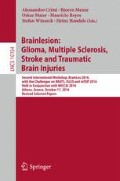Abstract
We propose an ensemble of deep neural networks for the two tasks of automated prognosis of post-treatment ischemic stroke, as imposed by the ISLES 2016 Challenge. For lesion outcome prediction, we employ an ensemble of three-dimensional multiscale residual U-Net and a fully convolutional network, trained using image patches. In order to handle class imbalance, we devise a multi-step training strategy. For clinical outcome prediction, we combine a convolutional neural network (CNN) and a logistic regression model. To overcome the small sample size and the need for whole brain image, we use the CNN trained using patches as a feature extractor and trained a shallow network based on the extracted features. Our ensemble approach demonstrated an appealing performance on both problems, and is ranked among the top entries in the Challenge.
Y. Choi, Y. Kwon and H. Lee—Contributed equally.
Access this chapter
Tax calculation will be finalised at checkout
Purchases are for personal use only
References
ISLES 2016 challenge. http://www.isles-challenge.org/
Chollet, F.: Keras (2015). https://github.com/fchollet/keras
Çiçek, Ö., Abdulkadir, A., Lienkamp, S.S., Brox, T., Ronneberger, O.: 3D u-net: learning dense volumetric segmentation from sparse annotation. CoRR abs/1606.06650 (2016). http://arxiv.org/abs/1606.06650
Clevert, D., Unterthiner, T., Hochreiter, S.: Fast and accurate deep network learning by exponential linear units (ELUs). CoRR abs/1511.07289 (2015). http://arxiv.org/abs/1511.07289
Dieleman, S., Schlter, J., Raffel, C., Olson, E., Snderby, S.K., Nouri, D., Maturana, D., Thoma, M., Battenberg, E., Kelly, J., Fauw, J.D., Heilman, M., de Almeida, D.M., McFee, B., Weideman, H., Takcs, G., de Rivaz, P., Crall, J., Sanders, G., Rasul, K., Liu, C., French, G., Degrave, J.: Lasagne: first release. http://dx.doi.org/10.5281/zenodo.27878
Goodfellow, I.J., Warde-Farley, D., Mirza, M., Courville, A.C., Bengio, Y.: Maxout networks. ICML 3(28), 1319–1327 (2013)
Havaei, M., Davy, A., Warde-Farley, D., Biard, A., Courville, A., Bengio, Y., Pal, C., Jodoin, P.-M., Larochelle, H.: Brain tumor segmentation with deep neural networks. Med. Image Anal. 35, 18–31 (2017). Elsevier
Havaei, M., Guizard, N., Larochelle, H., Jodoin, P.: Deep learning trends for focal brain pathology segmentation in MRI. CoRR abs/1607.05258 (2016). http://arxiv.org/abs/1607.05258
He, K., Zhang, X., Ren, S., Sun, J.: Deep residual learning for image recognition. In: Proceedings of the IEEE Conference on Computer Vision and Pattern Recognition, pp. 770–778 (2016)
He, K., Zhang, X., Ren, S., Sun, J.: Delving deep into rectifiers: surpassing human-level performance on imagenet classification. In: Proceedings of the IEEE International Conference on Computer Vision (2015)
He, K., Zhang, X., Ren, S., Sun, J.: Identity mappings in deep residual networks. In: Leibe, B., Matas, J., Sebe, N., Welling, M. (eds.) ECCV 2016. LNCS, vol. 9908, pp. 630–645. Springer, Cham (2016). doi:10.1007/978-3-319-46493-0_38
Ioffe, S., Szegedy, C.: Batch normalization: accelerating deep network training by reducing internal covariate shift. CoRR abs/1502.03167 (2015). http://arxiv.org/abs/1502.03167
Kamnitsas, K., Ledig, C., Newcombe, V.F.J., Simpson, J.P., Kane, A.D., Menon, D.K., Rueckert, D., Glocker, B.: Efficient multi-scale 3D CNN with fully connected CRF for accurate brain lesion segmentation. CoRR abs/1603.05959 (2016). http://arxiv.org/abs/1603.05959
Kingma, D.P., Ba, J.: Adam: a method for stochastic optimization. CoRR abs/1412.6980 (2014). http://arxiv.org/abs/1412.6980
Lai, M.: Deep learning for medical image segmentation. CoRR abs/1505.02000 (2015). http://arxiv.org/abs/1505.02000
Long, J., Shelhamer, E., Darrell, T.: Fully convolutional networks for semantic segmentation. In: Proceedings of the IEEE Conference on Computer Vision and Pattern Recognition, pp. 3431–3440 (2015)
Menze, B.H., Jakab, A., Bauer, S., Kalpathy-Cramer, J., Farahani, K., Kirby, J., Burren, Y., Porz, N., Slotboom, J., Wiest, R., et al.: The multimodal brain tumor image segmentation benchmark (brats). IEEE Trans. Med. Imaging 34(10), 1993–2024 (2015)
Ronneberger, O., Fischer, P., Brox, T.: U-net: convolutional networks for biomedical image segmentation. CoRR abs/1505.04597 (2015). http://arxiv.org/abs/1505.04597
Saver, J.L., Goyal, M., van der Lugt, A., Menon, B.K., Majoie, C.B., Dippel, D.W., Campbell, B.C., Nogueira, R.G., Demchuk, A.M., Tomasello, A., et al.: Time to treatment with endovascular thrombectomy and outcomes from ischemic stroke: a meta-analysis. Jama 316(12), 1279–1288 (2016)
Shah, A., Kadam, E., Shah, H., Shinde, S.: Deep residual networks with exponential linear unit. In: Proceedings of the Third International Symposium on Computer Vision and the Internet. ACM (2016)
Zeiler, M.D.: Adadelta: an adaptive learning rate method. arXiv preprint arXiv:1212.5701 (2012)
Acknowledgments
This research was supported by the National Research Foundation of Korea (NRF) grant funded by the Korean government (MSIP, No. 2016012002). Joong-Ho Won’s research was partially supported by the National Research Foundation of Korea (NRF) grant funded by the Korean government (MSIP, Nos. 2013R1A1A1057949 and 2014R1A4A1007895).
Author information
Authors and Affiliations
Corresponding author
Editor information
Editors and Affiliations
Rights and permissions
Copyright information
© 2016 Springer International Publishing AG
About this paper
Cite this paper
Choi, Y., Kwon, Y., Lee, H., Kim, B.J., Paik, M.C., Won, JH. (2016). Ensemble of Deep Convolutional Neural Networks for Prognosis of Ischemic Stroke. In: Crimi, A., Menze, B., Maier, O., Reyes, M., Winzeck, S., Handels, H. (eds) Brainlesion: Glioma, Multiple Sclerosis, Stroke and Traumatic Brain Injuries. BrainLes 2016. Lecture Notes in Computer Science(), vol 10154. Springer, Cham. https://doi.org/10.1007/978-3-319-55524-9_22
Download citation
DOI: https://doi.org/10.1007/978-3-319-55524-9_22
Published:
Publisher Name: Springer, Cham
Print ISBN: 978-3-319-55523-2
Online ISBN: 978-3-319-55524-9
eBook Packages: Computer ScienceComputer Science (R0)

